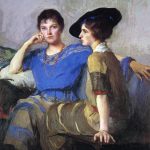Kate Perugini, born Catherine Elizabeth Macready Dickens on October 29, 1839, was a British painter of the Victorian era, notable not only for her artistic talent but also as the daughter of the famed novelist Charles Dickens. Kate’s life was deeply intertwined with the cultural milieu of 19th-century Britain, a connection that significantly influenced her career and personal life.
From a young age, Kate was exposed to the artistic and literary circles that frequented her father’s home, including many prominent figures of the time. This environment nurtured her artistic inclinations and provided her with opportunities to study and develop her skills. She received formal art training, which was somewhat unusual for women of her era, demonstrating both her talent and the support she received from her family.
Kate’s work primarily focused on portraiture, through which she captured the likenesses of various individuals with sensitivity and depth. Her style was reflective of the Victorian aesthetic, characterized by its attention to detail, rich colors, and emphasis on the emotional state of her subjects. Despite the challenges faced by women artists in gaining recognition during the Victorian period, Kate managed to carve out a space for herself in the art world, exhibiting her works at various venues including the Royal Academy of Arts.
Her personal life, much like her professional one, was marked by connections to notable personalities of the time. In 1860, she married Charles Allston Collins, a painter and writer who was an acquaintance of her father. After Collins’s death, she married another artist, Charles Edward Perugini, in 1874. Perugini was an Italian-born painter who had established himself in England, and their marriage formed a partnership that further immersed Kate in the artistic community. Together, they were part of a vibrant social circle that included many artists, writers, and actors of the Victorian era.
Kate’s relationship with her father, Charles Dickens, was complex and multifaceted. She was reportedly his favorite child, and her marriages to men who were part of the literary and artistic worlds suggest that she remained deeply connected to her father’s legacy throughout her life. However, she also sought to establish her own identity and reputation independently of her famous surname, a challenge faced by many children of renowned figures.
After her father’s death in 1870, Kate became an active preserver of his memory and legacy, contributing to various memorials and publications about his life and work. Her own legacy, however, is that of a talented artist who navigated the constraints of her time to pursue her passion for painting. While her works may not have achieved the same level of fame as her father’s literary output, they offer valuable insights into the Victorian era’s cultural and artistic landscapes.
Kate Perugini’s contributions to Victorian art, though perhaps overshadowed by her father’s towering literary legacy, reflect the rich tapestry of cultural and artistic endeavors that characterized 19th-century Britain. Her life and work serve as a testament to the role of women in the arts during this period, highlighting the challenges and achievements of female artists in a predominantly male-dominated field. Kate Perugini passed away on May 9, 1929, leaving behind a body of work that continues to be appreciated by those interested in Victorian art and the Dickens family legacy.






